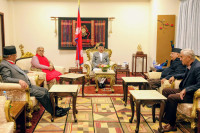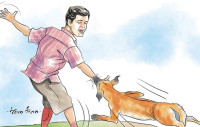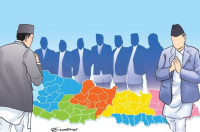Opinion
Beyond buses
Roads need to represent our realities not only serve four-wheelers
Brabim Kumar & Samrat Katwal
In the near future, we will have many new roads in Nepal. Kathmandu will have an eight-lane Ring Road built with Chinese support. The Kath-mandu-Hetauda fast track road is also underway and the Japanese are helping us build the Banepa-Bardibas Highway. Additionally, planning is underway for the Sitapaila-Dharke road with support from Kuwait. Without a doubt, roads belong to people from every strata, regardless of age, gender, physical ability or the mode of transport. However, will the new roads represent and serve us all? And do Nepali roads necessarily need to be based on the traditional notion of being spaces catering mostly to vehicles that run on fossil fuels? Alternatively, can Nepal build something different to cater to the needs of larger society? It might be worthwhile to ponder n how these planned roads represent us and our diverse Nepali populace.
Whose roads?
Traditionally, our roads were only trails and served different purposes. They functioned as a chautaris where people socialised, sellers found a nice flat stone to sit on and hawk their wares without fear of harassment and children played chor-police without the risk of coming under a car. Today, the chautaris have been replaced by bus stops where people act like relay runners, always in a rush to board the next arriving micro. Vendors who make a living on the roads are taken to be a nuisance and now, the Kathmandu Metropo-litan City has been instructed by Home Minister Bamdev Gautam to sweep them away. Though the feudal Ranas’ or badahakim’s horse chariots have long been extinct, the rides of commoners still have to give way to a minister’s parade which comes screaming by to dominate and claim the roads. Theoreti-cally, we all disagree that roads only belong to those in power or the rich. In practice, most bicyclists or vendors carrying vegetables have at least one experience of being screamed at by someone on a Pulsar bike or frowned upon by another in sunglasses inside a sleek private car for occupying the road.
Travelling in Nepal still consists of multiple mediums of transport, wherein pedestrians, individuals carrying voluminous loads, thelas (human-powered carts), bullock carts in the Tarai, cycles carrying vegetables, rikshaws, motorcycles, private cars and public four- and three-wheelers exist together. In a way, Nepali roads consist of all mediums of road transport that have evolved since humans started using transport, except for modern trains and metros. So if all these modes of transport exist in Nepal, isn’t the prevalent concept of a road—which has lead to the construction of multi-lane roads designed especially for fossil fuel vehicles—displacing other forms of transport?
Many families used to possess bullock carts in and around Charpane VDC adjoining Birtamod of Jhapa. But today, very few exist. The primary reason for this is the bullock-cart unfriendly East West Highway. Therefore, people have to carry their own loads as no fossil-fuel public vehicles serve the feeder roads nor connect the suburbs of Charpane to Birtamod.
Road for all
In Kathmandu, few cycle lanes like the one in Sinamangal have become functional. The ongoing Ring Road expansion also envisages a cycle lane. Nepali roads, however, need more than a few cycle lanes. Our roads need to be made more representative by incorporating other modes of transport that represent the Nepali people. Rickshaws are important in the Tarai. Thelas are necessary in urban locations like Bhimsenthan in Basantapur. Likewise, a horse-pulled tanga is central to life in Nepaljung, just as footpaths wide enough for a daughter to hold both her father and mother’s hand and walk are required everywhere.
Of our kind Wouldn’t Nepali roads be lifeless without our roadside didi-bahinis and daju-bhais selling affordable products while also making a living? Unlike what our Home Minister thinks, the 50,000 to 60,000 people who serve the citizens of Kathmandu from the streets are not a nuisance. These vendors make our streets bright with their lights and safe with their presence. A street vendor can also be expected to be more active than a CCTV in preventing crimes.
Jane Jacobs, in her book The Death and Life of Great American Cities, identifies street vendors as the “eyes on the street”, who due to their long and continuous presence on the streets are capable of preventing harm, detecting wrongs and providing immediate help when needed. This is particularly relevant for a country like ours. Street vendors are an important part of our roads and their function surely cannot be overlooked.
In Nepal, we have a tendency to compare our roads with smooth ones in the US or Europe. We have a rigid notion of what a good road is. At times, it seems that our notion of roads is more influenced by Hollywood movies than our own local needs and the characteristics of our population. We need to break free from our rigid construct. Our roads need to respect and incorporate all modes of transport: eco-friendly bullock carts and horse carts to thelas and rickshaws. No matter the size and number of lanes, our streets can still be a place where vendors coexist with pedestrians. We need to understand roads beyond just their function as spaces to drive four wheelers and improvise upon them to represent our realities.
Katwal and Karki are researchers at the Hands-On Institute




 15.12°C Kathmandu
15.12°C Kathmandu











